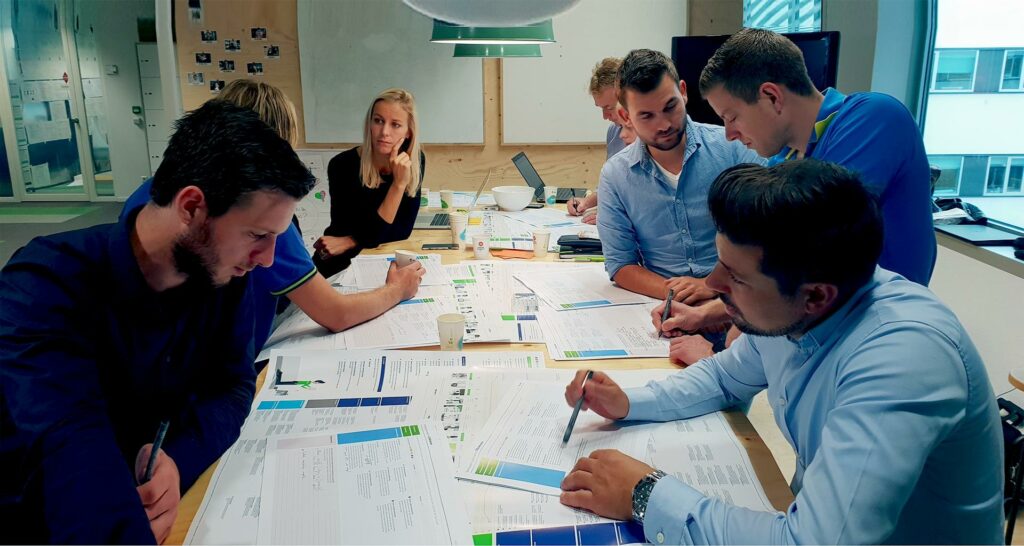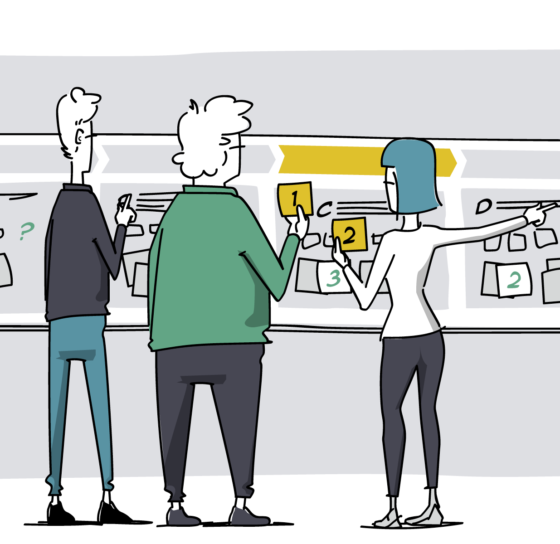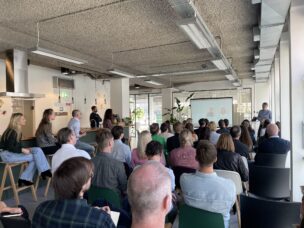Almost every organization has customer experience on the agenda, or at least on the to-do list. Based on our passion and sincere conviction that customer experience makes sustainable growth possible, we naturally welcome this.
That’s why we want to ask you something:
What do you need to develop the right customer experience activities?
A) A research report of 80 slides.
B) A poster of a customer journey map.
C) A roadmap with concrete action points.
The report does not fit in any mailbox and contains so much information that it is overwhelming and you look at it fleetingly. The poster attracts attention for the first few days, but soon everyone passes it on their way to the next meeting or cup of coffee. The correct answer is of course C, the roadmap with concrete action points, because you can really get started with that. OK. How?
the customer journey map overboard?
There is a good chance that your organization has invested in the analysis in recent years, resulting in the journey poster, but has not yet been able to follow through. It often does not exceed the impact of a research report. And that’s a shame, because only when you have that roadmap with concrete action points can you start adding value. Are the analyzes and customer journeys wasted money? Certainly not. They are just not the end result. Although they provide insight and overview, they do not form a concrete action plan. They do not move an organization in isolation. They are tools to initiate change and are therefore a powerful starting point to make an impact on Customer Experience.
journey Design is done together
The poster on the wall therefore needs a concrete step. This requires active cooperation between disciplines to obtain a holistic picture of customer needs and then jointly arrive at an action plan. What exactly needs to be done? Why does it have to happen? Who should do it? You don’t answer these kinds of questions in an hour and certainly not alone. It is an iterative process in which you have to involve every stakeholder (from Product Owner to Developer) in the organization. By involving everyone in the process and making choices together, you no longer have to defend the insights and approach at a later time. This prevents a solution from remaining abstract or stranded due to insufficient support.
The poster on the wall needs a concrete step.
determine the course with the customer journey map
You use the customer journey map, with validated customer insights, as a guideline for approval and coordination. The customer value, business value and the interrelationship are then clear to everyone. By working with pre-validated customer insights, you also avoid internal subjective discussion: the insight is a given. The opportunities (or: opportunities for improvement) that you determine together then form the focus, and thus the starting point, for taking action. The customer insights indicate unchanged how important a focus point is from a customer perspective: that determines the priority you give to an opportunity, not the opinion of Hans, Piet or Klaas.
You will find that some of these opportunities overlap from a customer perspective, impacting the same stage or touchpoint in the customer journey. But it may just be that there is no overlap within the organization. Then the customer journey helps to clarify which activities you need to coordinate and which teams need to work together. You may also find out that you currently have no influence whatsoever on some phases or touchpoints in the customer journey. A great opportunity to think about new propositions or functionalities together with the relevant stakeholders to improve the customer experience!

making opportunities specific
Often the opportunities will still be a bit general and you will have to work them out further to make them specific, measurable and result-oriented. You do this by assigning customer values and company values based on a hypothesis: if we work on opportunity A, we expect to achieve result X. After handing out the scores, you also want insight into the effort required to achieve the desired result. How much work is it really?
Based on the combination of customer value, business value and effort, you jointly prioritize opportunities for improvement and make choices. Choices that everyone commits to. It is then time to work out the improvement opportunities in why, what and how.
- Why? Why do we want to focus on this? It’s about customer value. What is the customer need, where is the pain point and who are we doing it for?
- What? What are we going to do to solve this and what will it yield? Then you’re talking about business value. Which KPIs influence you, which effect do you promise?
- How? How do you deliver the solution. This is the effort and the concept solution. How are you going to solve it? Is it concrete enough for a Scrum team to pick up on? Is an in-depth study required via a design sprint? Or is it the start of a new proposition?
Shape the opportunities by formulating answers to the three layers with all disciplines in the organization. And don’t forget to designate an owner who will pull the cart so that it doesn’t float somewhere. It is important to make firm agreements. Then your customer experience activities are supported organization-wide: people understand what they do and why they do it. All opportunities go into the organization and come off that poster on the wall. This is how you get an organization moving from one ambition and you come to concrete actions. Actions that ensure a measurable impact on the customer experience and the bottom line.
More information? Feel free to contact us at hello@essense.eu









